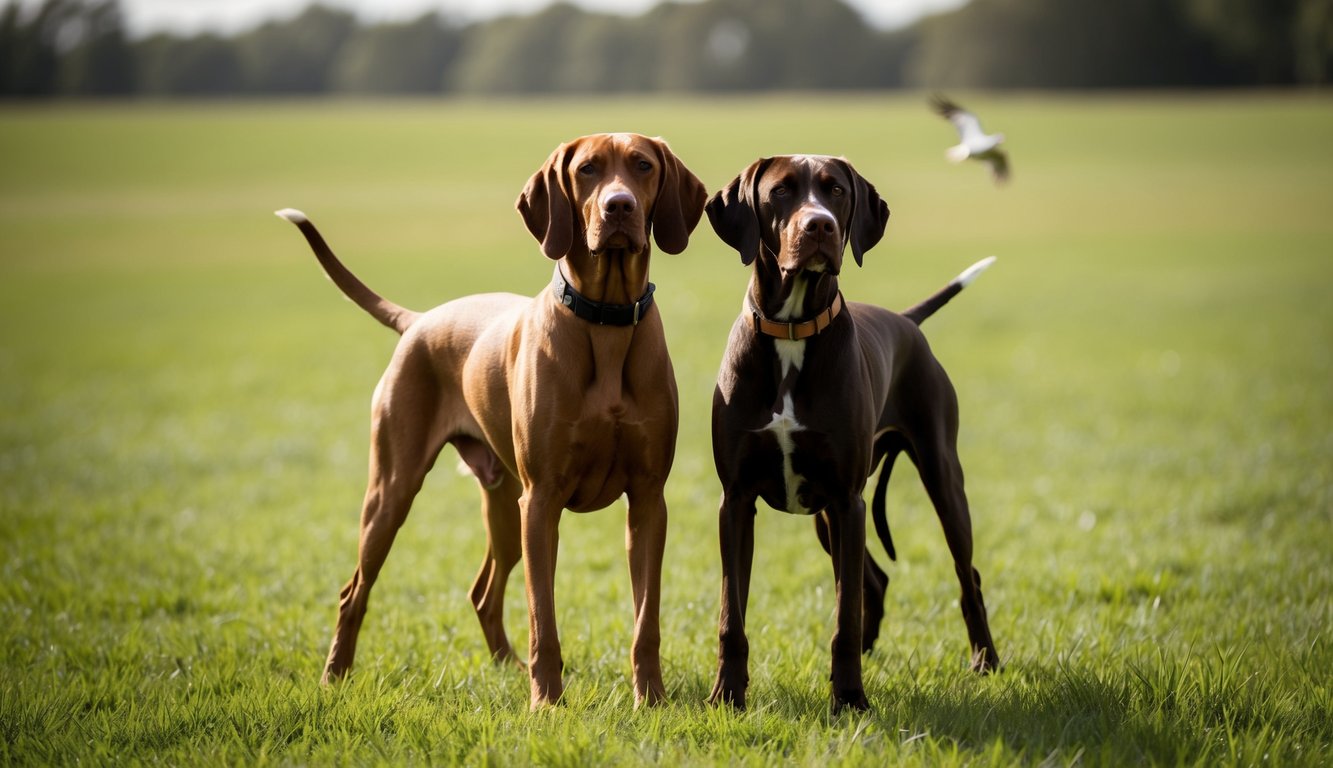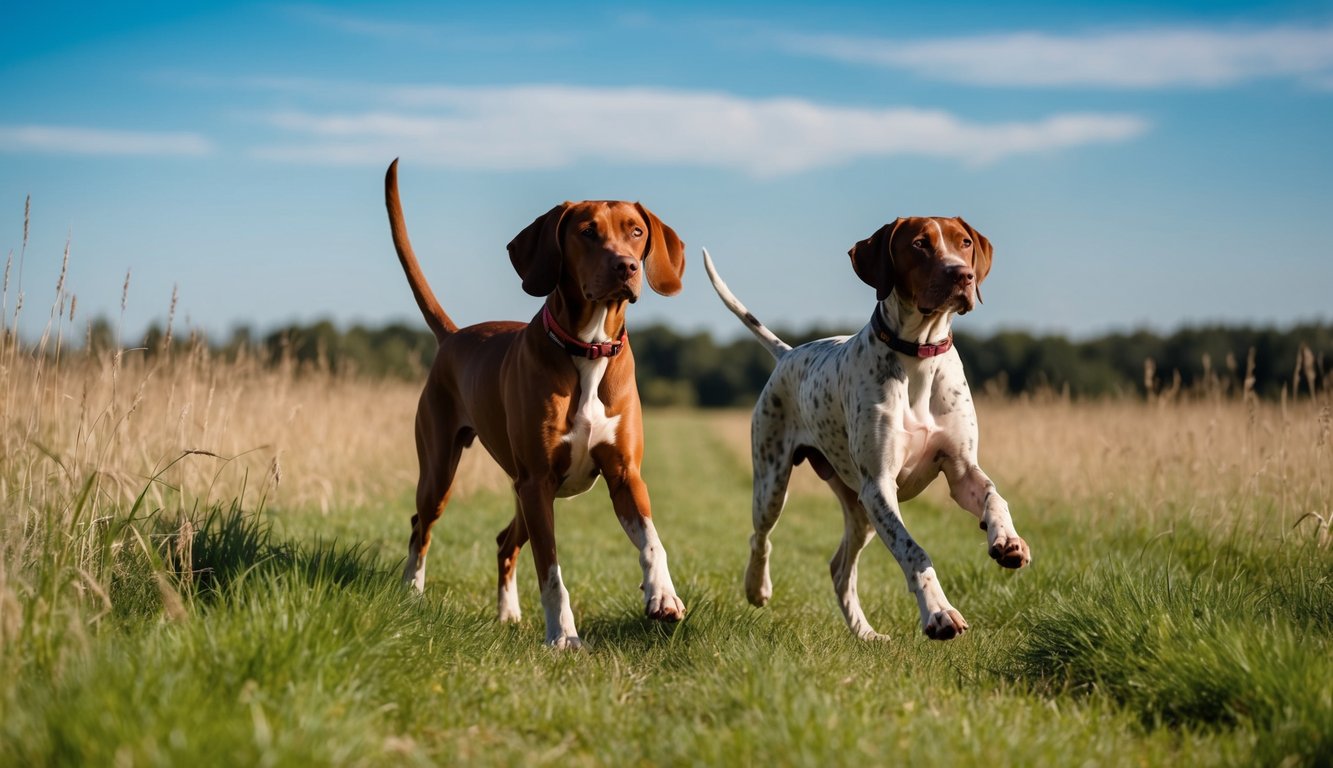The Vizsla and Pointer are both well-known sporting dog breeds with rich histories. The Vizsla originated in Hungary, where it was bred as a versatile hunting companion. This breed dates back to the 10th century and is also known as the Hungarian Vizsla or Rövidszőrű Magyar Vizsla.
Pointers have roots in several European countries. The English Pointer, for example, was developed in the United Kingdom. The German Shorthaired Pointer, as its name suggests, comes from Germany.
Both breeds fall under the sporting dog classification. But let’s take a closer look at the similarities and differences between these two breeds.
Physical Characteristics
Vizslas and Pointers have distinct physical traits that set them apart as sporting dogs. Their size, weight, coat, and athletic abilities contribute to their unique appearances and capabilities in the field.
Size Comparison
- Vizslas and Pointers differ in size. Vizslas are medium-sized dogs, standing 21-24 inches tall at the shoulder for males and 21-23 inches for females.
- Pointers are slightly larger, with males reaching 25-28 inches and females 23-26 inches at the shoulder. This size difference can impact their performance in various hunting scenarios.
- The extra height gives Pointers a longer stride, which can be advantageous when covering large areas during hunts.
Weight Statistics
- Vizslas typically weigh between 45-65 pounds, with males being heavier than females. Their lean build contributes to their agility and endurance.
- Pointers are generally heavier, weighing 55-75 pounds. The extra weight of Pointers can provide more power and stability in challenging terrains.
- Both breeds maintain a muscular physique, essential for their sporting roles. Their weight-to-height ratio is carefully balanced to ensure optimal performance.

Coat Type and Breed Colors
Vizslas have a short, smooth coat that lies close to the body. They are known for their distinctive golden-rust color, which can range from light to deep red.
Pointers also have a short, dense coat. They come in various colors and patterns:
- Liver
- Black
- Orange
- Lemon
- Combinations with white
The coat of both breeds requires minimal grooming, making them low-maintenance in this aspect.
Speed and Agility
Both Vizslas and Pointers are known for their impressive speed and agility. Vizslas can reach speeds up to 40 mph, while Pointers can hit 45 mph in short bursts. Their athletic builds allow for quick turns and sudden stops, crucial for tracking and pointing game. Vizslas are often described as more nimble, while Pointers have a powerful, ground-covering gait.
These breeds excel in activities that showcase their speed and agility, such as:
- Field trials
- Agility competitions
- Dock diving
Their physical attributes make them well-suited for long days of hunting and outdoor activities.
Temperament and Personality Traits
Vizslas and Pointers have distinct personalities that shape their interactions with humans and other animals. These traits influence their suitability for different homes and lifestyles.
Affectionate Nature
- Vizslas are known as velcro dogs due to their strong attachment to their owners. They crave physical touch and often try to be as close as possible to their family members.
- Vizslas form deep bonds and can be prone to separation anxiety if left alone for long periods.
- Pointers are also affectionate but tend to be more independent. They show love through their loyalty and eagerness to please rather than constant physical contact.
- Pointers can adapt well to being alone for reasonable periods, making them suitable for working families.
Energy Level and Playfulness
- Vizslas are known for their boundless energy and love of play. They require daily vigorous exercise and mental stimulation to stay happy and healthy.
- Pointers are athletic and agile, with a strong drive for physical activity. They excel in activities like running, hiking, and swimming. Pointers need regular exercise to prevent boredom and destructive behaviors.
Intelligence and Trainability
- Vizslas are highly intelligent and eager to please. They pick up commands quickly and enjoy learning new tasks. Positive reinforcement works well with this sensitive breed.
- Pointers are also smart and trainable. They have a strong hunting instinct, which can make them easily distracted during training. Consistent, patient training yields excellent results with Pointers.
- Both breeds benefit from early socialization and obedience training to channel their energy and intelligence positively.
Protective and Watchdog Rating
- Vizslas are moderately protective of their families. They may bark to alert their owners of strangers but are generally not aggressive. Their strong bond with family members makes them naturally watchful.
- Pointers are not typically known for their guarding instincts. They may bark at unusual sounds or sights but are often too friendly to be effective guard dogs. Their alert nature can make them good watchdogs, signaling when something is amiss.
- Neither breed is considered aggressive, but both can be territorial about their home and family.
Social Needs and Stranger Friendliness
- Vizslas are very social dogs that thrive on human companionship. They tend to be friendly with strangers and get along well with other dogs when properly socialized. Vizslas often struggle when left alone and may develop anxiety or destructive behaviors.
- Pointers are generally friendly and outgoing with both people and other dogs. They adapt well to new situations and enjoy meeting new people. While they appreciate human company, Pointers are typically more independent than Vizslas and can handle being alone for longer periods.
- Both breeds benefit from early and ongoing socialization to ensure they remain well-adjusted and confident in various situations.
Health and Lifespan
Both Vizslas and Pointers are generally healthy breeds, but they can face some health issues. Their lifespans are similar, with proper care and attention to their specific needs.
Common Health Issues
- Vizslas and Pointers may encounter hip dysplasia, a condition affecting the hip joint. This can cause pain and mobility issues. Both breeds can also develop eye problems like progressive retinal atrophy.
- Ear infections are another concern, especially for Pointers due to their floppy ears. Regular ear cleaning can help prevent these issues.
- Allergies can affect both breeds, leading to skin irritation or digestive problems. Identifying and avoiding triggers is key to managing allergies.
Exercise Needs and Health Concerns
- Vizslas and Pointers are high-energy dogs that need plenty of exercise. Daily activities like running, swimming, or hiking are essential for their physical and mental well-being.
- Lack of exercise can lead to obesity, which puts strain on joints and organs. It can also result in behavioral problems due to pent-up energy.
- Both breeds benefit from mentally stimulating activities. Puzzle toys and training sessions can help keep their minds sharp and prevent boredom-related issues.
Breed-Specific Conditions
- Vizslas may be prone to lymphoma and hemangiosarcoma, types of cancer that require early detection and treatment. Regular check-ups can help catch these conditions early.
- Pointers might be more susceptible to epilepsy, a neurological disorder causing seizures. Proper medication and management can help control this condition.
- Both breeds can live 12-15 years with good care. Regular vet check-ups, a balanced diet, and adequate exercise are crucial for a long, healthy life.
Training and Behavior
Vizslas and Pointers are both highly trainable sporting dogs with strong hunting instincts. They require consistent training and plenty of mental and physical stimulation to thrive.
Obedience Training Techniques
Both breeds respond well to positive reinforcement methods. Treats, praise, and play are effective rewards for good behavior. Short, frequent training sessions work best to keep their attention.
Vizslas are quick learners and adapt well to training. They excel in obedience and agility tasks. Pointers may be slightly more independent, but they’re still intelligent and trainable.
Consistency is key for both breeds. Clear commands and expectations help them understand what’s required. Early training and socialization are crucial for developing well-mannered adult dogs.
Hunting Abilities and Prey Drive
Vizslas and Pointers are exceptional hunting companions. Their strong prey drive makes them natural hunters, but it can also lead to chasing small animals if not properly managed. Pointers have a keen ability to locate and “point” at game birds. They work well at a distance from their handler. Vizslas are versatile hunters, excelling at both pointing and retrieving.
Both breeds have high energy levels and stamina, allowing them to hunt for hours. They require regular exercise and mental stimulation to prevent boredom and destructive behaviors.
- Pointer strengths:
- Excellent at locating game
- Work well at a distance
- Strong pointing instinct
- Vizsla strengths:
- Versatile hunter
- Close-working style
- Strong retrieving instinct

Adaptability to Training and Living Environment
- Vizslas are known for their adaptability. They can adjust to various living situations as long as their exercise needs are met. They form strong bonds with their owners and prefer to be close by.
- Pointers are more independent but still need plenty of human interaction. They can adapt to different environments but thrive with access to open spaces for running and exploring.
- Both breeds need mental stimulation. Puzzle toys, training exercises, and scent work can help keep their minds engaged. Without proper outlets, they may develop problem behaviors.
Socialization and Interaction
- Early socialization is crucial for both Vizslas and Pointers. Exposure to various people, animals, and environments helps them develop into well-adjusted adults.
- Vizslas are known as “velcro dogs” due to their strong attachment to their owners. They often seek physical contact and can be prone to separation anxiety if not properly trained.
- Pointers are generally friendly but may be slightly more reserved with strangers. They typically get along well with other dogs and can be good with children when properly socialized.
Both breeds benefit from regular interaction with other dogs and people. Dog parks, training classes, and supervised playdates can help meet their social needs.
Living Conditions and Compatibility
Vizslas and Pointers have distinct needs when it comes to living conditions. Their compatibility with different lifestyles can impact their happiness and well-being. Let’s explore how these breeds adapt to various environments and family situations.
Family Integration and Affection
- Vizslas are known as velcro dogs. They form strong bonds with their families and crave constant attention. These dogs excel in homes where someone is usually present.
- Pointers are also affectionate but less clingy. They enjoy family time while maintaining some independence.
- Both breeds are good with children when properly socialized. Vizslas may be more gentle, while Pointers can be a bit boisterous.
- For protection, neither breed is considered a guard dog. However, their alertness makes them good watchdogs.
Adaptability to Different Lifestyles
- Vizslas need lots of exercise and mental stimulation. They fit best with active families who can provide at least 1-2 hours of activity daily.
- Pointers also require significant exercise but may be more adaptable to varying activity levels. They can adjust to less intense routines if needed.
- Both breeds can live in apartments if given enough exercise. Vizslas may struggle more with apartment living due to their high energy and need for closeness.
- Regular outdoor time is crucial for both. A fenced yard is ideal but not necessary if daily walks and runs are provided.
Environmental and Climate Tolerance
- Vizslas and Pointers have short coats that offer little protection from extreme weather. They are sensitive to cold and may need sweaters in winter.
- Heat tolerance is better, but neither breed should be left outside in hot weather for long periods. They need shade and water when it’s warm.
- Vizslas may be more sensitive to environmental changes. They can get stressed by loud noises or unfamiliar situations.
- Pointers tend to be more adaptable to different environments. They often handle new situations with less anxiety.
- Both breeds shed moderately. Regular brushing helps keep their coats healthy and reduces loose hair in the home.





